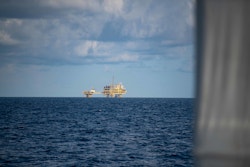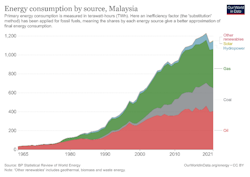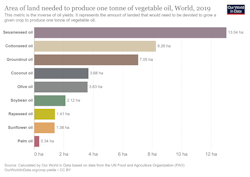Malaysia, the roadmap for energy transition
Malaysia has been home to our boat for quite some time now. After so many miles and before many more, Energy Observer comes out from a technical stopover in Langkawi Island, ready to explore the last country of Southeast Asia, starting by its energy roadmap.
Like other countries in the region, Malaysia - with its easily recognisable tall towers in Kuala Lumpur, the numerous islets dotting its seas, its mountains popping out of the forests - is a blend of modern world and nature and a country which is fast developing on several aspects. Here we will focus on the energy landscape and the challenges facing the country to meet its carbon reduction objectives.
An unequal distribution of energy
Lying north of Singapore, Malaysia is composed of two non-contiguous regions separated by the South China Sea: Peninsular and East Malaysia. This geographical discontinuity reflects in the energy market too: oil and gas reserves are situated in remote, dispersed areas, far from the high-consumption regions of Malay peninsula. Hence, the country’s energy market too is segmented into two sub-units: West Malaysia’s eastern coast offshore platforms and underwater gas pipelines - which we sailed through during our navigation from Vietnam - supply the domestic market while the fields off the northern part of East Malaysia export to the international market instead.
A hydrocarbon surplus in the east and insufficient reserves in the west: this spatial disjuncture between the country’s producing and consuming areas explains why the country is simultaneously a hydrocarbon exporter and importer.

Heading to Tioman, Malaysia
To compensate for such unequal distribution of hydrocarbons, Malaysia takes advantage of its geographical position on the Strait of Malacca. This narrow waterway that flows between Indonesian Sumatra Island and Malay peninsula is a hub of global trade and hosts over a quarter of the world trade.
For centuries, merchant vessels have sailed from the Indian Ocean to Eastern Asia through a small channel tucked inside Southeast Asia but since the 17th century up today, Malacca’s strait has become the main bridge to and from Asia, acting as a primary transit route for vital commodities to feed the quickly growing Asian economies. It became, among others, an energy corridor. In 1993, roughly 7 million barrels per day of oil and petroleum products - namely 20% of world maritime oil trade - flowed through the strait. Less than 20 years later that figure was more than twice as much, representing about one third of all seaborne oil and 19 times the amount shipped via the Panama Canal.

Energy Observer in Singapore, 2022
Energy and economic development: two tied rings
There was a time when discussions about energy and development were considered separate discourses. They merged into the common call for electricity access for the lower-income population in developing countries. Thanks to energy, we heat and cool our homes, we lighten buildings, drive cars, move freight and manufacture products which are indispensable on our daily lives.
Energy is a major driver of economic growth: energy and well-being go hand in hand.
This trend is particularly true for developing countries like Malaysia, where energy demand and supply are still closely linked to economic development.
Malaysia’s economy is today among the strongest, fastest growing and most diversified in Southeast Asia. Its GDP increased by 300%, namely by a factor of 4, in the last 20 years, making the country enter in the circle of high-income countries.
Malaysia benefits from many assets that explain its growth trajectory. The downstream production industry from local natural resources - notably hydrocarbons and palm oil - is one of these.
The country is a major hydrocarbon producer: it is the second largest oil and natural gas producer in Southeast Asia and the fifth biggest exporter of LNG in the world, as of 2019.
For a long time, the government has financed fossil fuels production via upstream investment and exploration, but this pathway is becoming more and more tricky to pursue due to declining reserves of oil coupled with a steep increase in domestic consumption. At the current consumption rate of about 260 million barrels a year3, Malaysia will run out of oil in around 14 years. There is oil at increased depths and in other less accessible deposits, but it is not economically viable nor environmentally justified to tap into these oil reserves. No matter how we slice the problem, Malaysia needs to turn to clean and abundant energies.
Climate promises and energy perspectives
Today, Malaysia relies almost equally on oil and natural gas to meet its energy needs. A total energy demand of 1164 TWh4, half of that of France’s, which is now met 91% by fossil fuels, oil and natural gas. These are giants compared to renewables. As a result, around 90% of the country’s CO2 emissions are due to the burning of these resources.

Energy Consumption by source, Malaysia
Considering that global emissions must peak within the next 3 years and decline by 43% by 2030, if we want to limit global warming to 1,5°C, renewable energy's role is instrumental.
There is a growing market for alternative energies, with the ongoing technological advancements that are likely to reduce the cost of purchasing accessible energy systems. With the goal of building a low carbon economy and reaching carbon neutrality by 2050 - way ahead of its Asean peers, Indonesia and Thailand - Malaysia targets a 31% of renewable installed capacity by 2025, compared to the current 23%. Today, hydropower is the main alternative energy source, making up 7% of the energy pie, the rest being diversified between solar, biomass, geothermal and waste, which account for less than 1%4. Recent subsidies have driven the country to become a key player in solar panel production yet, ironically, local adoption is still minimal.
Palm oil waste, an immense source of energy
Hydropower and solar are not the only trump cards. Biomass is too. Malaysia is the 2nd biggest palm oil producer, representing 27% of global palm oil production in 2019. Palm oil is everywhere, it is ubiquitous in a wide range of products: chocolate, cookies, margarine, makeup, soap, biofuel... Palm oil is an incredibly efficient crop compared to other vegetal oil crops: to obtain the same quantity of alternative oils like soya, coconut or sunflower oils we would need 4 to 38 times more land.

But what happens to the waste that accumulates when fruits are processed? As usual, massive agricultural industries result - besides the huge problems of deforestation and loss of wildlife habitat - in significant processing waste disposal problems, which generate methane, a gas with a global warming potential much higher than carbon dioxide. Thousands of tonnes of palm kernel shells stack up each year behind the mills and for a long-time operators did not know what to do with them.
Palm oil industry is a major driver of Malaysian economy, and the country certainly cannot give up on it. At the same time, this sector is the primary producer of biomass in Malaysia so the answer to the problem lies in finding smart solutions, some of which are already available. One option is burning this free biomass residue to slash emissions from fossil fuels. How can this help? During this process the biomass releases an amount of carbon equal to the one they have absorbed while growing, hence making combustion carbon neutral. Another option is converting the waste into bioenergy (biogas or biofuels) through thermochemical processes. Finding a way to valorise the enormous waste palm oil plantations create is, in the end, all about turning the problem into a solution.

Langkawi, Malaysia
Meeting the growing energy needs in a clean and environmentally sustainable way is a huge responsibility and a key challenge. Fuelling economic progress means a steady and secure energy supply and in a region like Southeast Asia, where the challenge of energy security is real and renewable potential is huge, clean energy sources are at the centre of the solution to tackle climate change.
They provide sustainable power, and all related projects can generate relevant economic spin-offs. Yet, cooperation is needed to get us to the finish line of an energy revolution.
To go further
The Strait of Malacca: from sultanates to Singapore I CIMSEC, 2022
The world's most important trade route? I World Economic Forum, 2014
Country Analysis Executive Summary: Malaysia I US Energy Information Administration, 2021
Malaysia: Energy Country Profile I Our World in Data